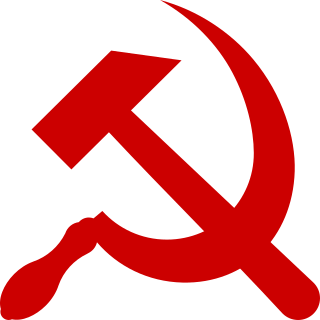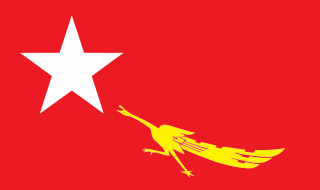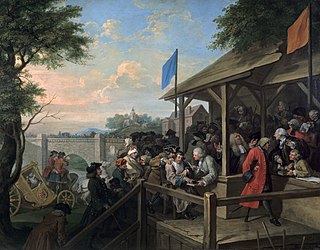Related Research Articles

The Union Jack, or Union Flag, is the national flag of the United Kingdom. The flag also has official status in Canada, by parliamentary resolution, where it is known as the Royal Union Flag. Additionally, it is used as an official flag in some of the smaller British overseas territories. The Union Flag also appears in the canton of the flags of several nations and territories that are former British possessions or dominions, as well as the state flag of Hawaii. The claim that the term Union Jack properly refers only to naval usage has been disputed, following historical investigations by the Flag Institute in 2013.

The hammer and sickle is a symbol meant to represent proletarian solidarity – a union between the peasantry and working-class. It was first adapted during the Russian Revolution, the hammer representing the workers and the sickle representing the peasants.

Pan-Africancolours is a term that may refer to two different sets of colours:

In politics, a red flag is predominantly a symbol of socialism, communism, Marxism, trade unions, left-wing politics, and historically of anarchism; it has been associated with left-wing politics since the French Revolution (1789–1799).

The National League for Democracy is a political party in Myanmar that was the ruling political party of Myanmar (Burma) from 2015 until the 2021 Myanmar coup d'état.

Political colours are colours used to represent a political ideology, movement or party, either officially or unofficially. It is the intersection of colour symbolism and political symbolism.

The current flag of Myanmar was adopted on 21 October 2010 to replace the former flag in use since 1974. The new flag was introduced along with implementing changes to the country's name, which were laid out in the 2008 Constitution.

The flag of Samoa was first adopted from February 24, 1949 for UN Trusteeships, and continuously applied for the state's independence on January 1, 1962. It consists of a red field with a blue rectangle in the canton. The blue rectangle bears the constellation Southern Cross: four large white stars and one smaller star.

Kayah State is a state of Myanmar. Situated in eastern Myanmar, it is bounded on the north by Shan State, on the east by Thailand's Mae Hong Son Province, and on the south and west by Kayin State. It lies approximately between 18° 30′ and 19° 55′ north latitude and between 96° 50′ and 97° 50′ east longitude. The area is 11,670 km2 (4,510 sq mi). Its capital is Loikaw. The estimated population in 1998 was approximately 207,357, according to UNICEF. It is inhabited primarily by the Karenni ethnic group, also known as Red Karen or Kayah, a Sino-Tibetan people.
Red flag may refer to:
The Indian Statutory Commission also referred to as the Simon Commission, was a group of seven Members of Parliament under the chairmanship of Sir John Simon. The commission arrived in British India in 1928 to study constitutional reform in Britain's largest and most important possession. One of its members was the future leader of the Labour Party Clement Attlee, who became committed to self-government for India.

The State Seal of Myanmar is used in all official government documents, including publications.For the honor of the State Seal, there are State Seal Law and Principles for the usages.
The Myanmar Maritime Trade Unions Federation, formerly known as Seafarers Union of Burma (SUB) is a trade union in Myanmar. It represents an estimated 20,000-30,000 workers in the international shipping industry, many of whom work on Flag of Convenience ships and suffer from poor work and pay conditions.

A naval ensign is an ensign used by naval ships of various countries to denote their nationality. It can be the same or different from a country's civil ensign or state ensign.

The first fourteen years of post-independence Burma were marked by several communist and ethnic-based insurgencies. Prominent insurgent groups during this period include the Communist Party of Burma led by Thakin Than Tun, Communist Party (Burma) led by Thakin Soe, the People's Volunteer Organisation led by Bo La Yaung, the Revolutionary Burma Army (RBA) led by communist officers Bo Zeya, Bo Yan Aung and Bo Yè Htut, and the Karen National Union (KNU).

The Burma Workers Party, until 1958 the Burma Workers and Peasants Party, was a communist party in Burma, formed on 8 December 1950 by leftist elements of the Socialist Party. In December 1962 it merged with the People's Comrade Party to form the United Workers Party. In March 1964, it was among the many parties banned by decree of the Revolutionary Council.
The Trade Union Congress (Burma) was a central trade union organization in Burma. The TUC(B) was founded by the Socialist Party in November 1945, in an attempt to counter the influence of the communist-led All Burma Trade Union Congress. Ba Cho was the President of TUC(B). The TUC(B) was an affiliate of the governing Anti-Fascist People's Freedom League.
The Red Flag Cultivators Unions was a peasants movement in Burma, linked to the Red Flag Communist Party and formed after the Red Flag Communist Party had broken away from the Communist Party of Burma. The Red Flag Cultivators Unions called on peasants not to pay rent or taxes.

The Communist Party (Burma), sometimes referred to as the Red Flag Communist Party, was a communist party in Burma. The party was formed after a more radical faction broke away from the Communist Party of Burma in 1946. In the same year, it began a protracted armed insurgency; first against British rule, then against the Burmese government. The party was led by Thakin Soe, a firebrand communist leader. In the mid to late 1970s, the party lost influence and was militarily defeated after the capture of Thakin Soe in 1978.
References
- ↑ Hensengerth, Oliver. Burmese CP in relations between China and Burma